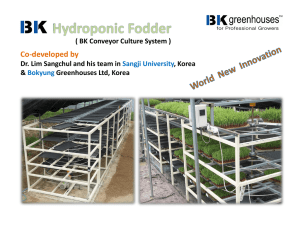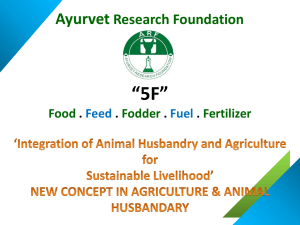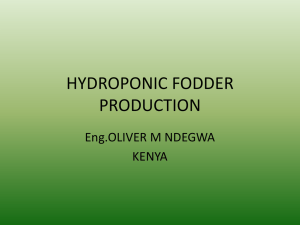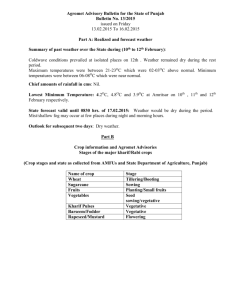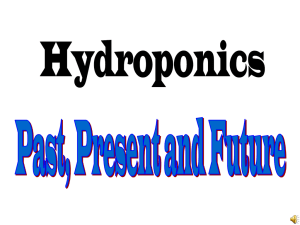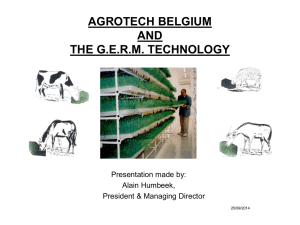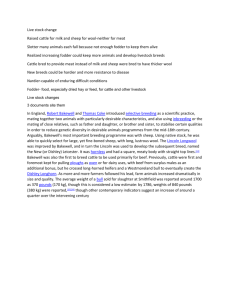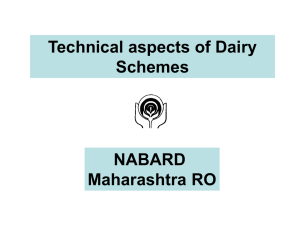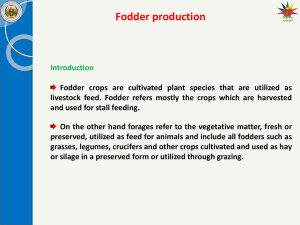Hydroponics - School Enterprise Challenge
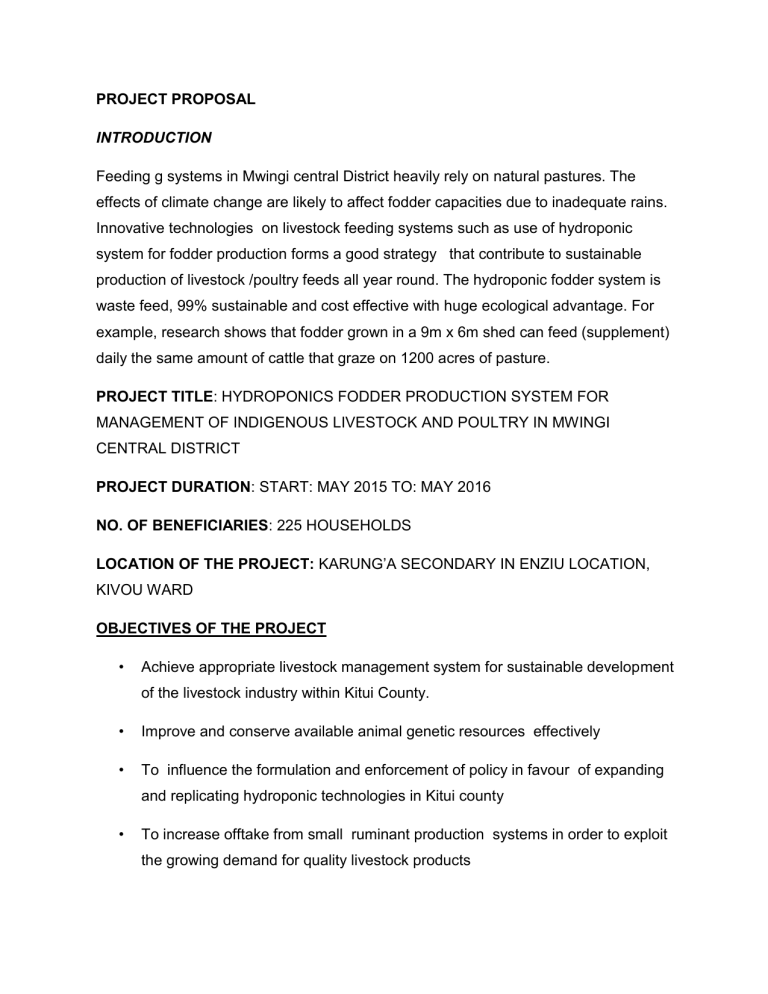
PROJECT PROPOSAL
INTRODUCTION
Feeding g systems in Mwingi central District heavily rely on natural pastures. The effects of climate change are likely to affect fodder capacities due to inadequate rains.
Innovative technologies on livestock feeding systems such as use of hydroponic system for fodder production forms a good strategy that contribute to sustainable production of livestock /poultry feeds all year round. The hydroponic fodder system is waste feed, 99% sustainable and cost effective with huge ecological advantage. For example, research shows that fodder grown in a 9m x 6m shed can feed (supplement) daily the same amount of cattle that graze on 1200 acres of pasture.
PROJECT TITLE : HYDROPONICS FODDER PRODUCTION SYSTEM FOR
MANAGEMENT OF INDIGENOUS LIVESTOCK AND POULTRY IN MWINGI
CENTRAL DISTRICT
PROJECT DURATION : START: MAY 2015 TO: MAY 2016
NO. OF BENEFICIARIES : 225 HOUSEHOLDS
LOCATION OF THE PROJECT:
KARUNG’A SECONDARY IN ENZIU LOCATION,
KIVOU WARD
OBJECTIVES OF THE PROJECT
• Achieve appropriate livestock management system for sustainable development of the livestock industry within Kitui County.
• Improve and conserve available animal genetic resources effectively
• To influence the formulation and enforcement of policy in favour of expanding and replicating hydroponic technologies in Kitui county
• To increase offtake from small ruminant production systems in order to exploit the growing demand for quality livestock products
• Achieve effective control of animal diseases and pests
• To increase the economic returns earned by small ruminant producers through organized collective production and marketing
• To improve access of small livestock producer to viable and sustainable services and inputs
• To catalyze venture creation and development
THE INTERVENTION FRAMEWORK
• The Sustainable Agriculture and Land Use Management with Innovations- Food security requires a mix of interventions that include drought resistant crops and animals. Innovations would simultaneously increase adaptive capacities and reduce vulnerability whilst mitigating climate change.
• The Participatory Market System Development- A way of understanding market systems by promoting dialogue among market actors.
• Sustainable Diversification of Livelihood Framework.- Diversifying rural economies with alternative livelihood perspectives.
THE INTERVENTION DRIVERS / THE MARKET CHALLENGE
• Improved income, livelihoods and poverty reduction
Livestock employs majority of people in Mwingi central District and the county as a whole and a great source of revenue generation. Not only will this action (model) directly lead to better incomes;but will also generate capital for use in alternative income generating activities and contribute to poverty reduction
• Meeting consumer demand for livestock and livestock products
International long term projections (from 1997-2020) indicate a substantial increase in volume of consumption of meat and milk,both in Sub-Saharan Africa and in the
Western Asian and North Africa region ,markets already served by Eastern Africa
pastoral systems. The increased consumer demand will need to be met by increased offtake rates and increased productivity of animals. Improving livestock fodder/ market systems can play a critical role in addressing these two objectives, directly in the case of higher offtake and indirectly by generating cash to allow investments in improved productivity.
ACTIVITIES TO BE CARRIED OUT
Time activity plan
2 days members site preparation / clearance responsibility
all gender
3 days
1 day sand & ballast transport to site bringing indigenous posts to site all gender members all male gender
members
2 days taking measurement of the unit Animal & allied ltd
1 day
Digging of holes / trenches transport of timber &inputs
20 members
Animal & allied ltd to site and one group
official
3 days actual construction work
Labour & support
Building water provision
Timber treatment
7 days
1 day curing of cement works outside fencing
Animal and allied ltd
6 young members all females members
2 youth
2 members all males members
7 days
3 days
1 day first batch feed production trainings commissioning of the micro
Project
Animal & allied ltd
Animal & allied ltd county officials
Ministry of
- agriculture
And Kenya
hydroponics ltd
DETAILED BUDGET (7M X 5M X3M HYDROPONICS UNIT)
• INPUTS / EQUIPMENT FOR THE PROJECT Amount
Number of trays 230 @ 500/=
Hydro cloth 14sx 5.25x 220/=
115,000/=
16,170/=
Hydro net 77m2 x 140/=
2 packs nutrients @ 600
Timber 2x1- 1380 fts x 18/=
10, 780/=
1200/=
24,840/=
2x2- 160 fts x 25/=
Posts 15 @ 10 fts x500/=
Posts 40 local @ 100/=
Rafter 18 pcs @ 500/=
Nails 4’’ – 8 kgs @ 160/=
21/2’’ – 10 kg @ 120/=
2’’ – 10 kg@ 100/=
4, 000/=
7500/=
4000/=
9000/=
1280/=
1200/=
1000/=
10 bags of cement @ 850
Sand 5 tons }group to provide
Ballast 4 tons} group to provide
Piping (green pvc) loft (4x 1000/=)
Gutters 6’’ x 6m (2 pcs ) @ 800/=
Supply tank 3200 litres
Reservoir tank 1000 litres
8500/=
10,000/=}
10,000/=
4000/=
1600/=
34,000/=
10,000/=
Piping accessories (connectors, elbow, timer dial and float pump) 13500/=
267,570/=
• OTHER COSTS
Installation labour (Kenya hydroponics ltd)
Transport of materials from Nairobi to our site/ farm
Communication charges
35,000/=
15,500/=
2000/=
Training (I week at Egerton University) for one farmer 50,000/=
Training (2 days for all members) ministry of agriculture officials (lunch & transport)
2000/=
Training stationery and photocopies (hand outs)
Bank charges
Emergencies (miscellaneous)
500/=
1000/=
2000/=
-------------------------
395,570.00
TOTAL PROJECT COST
GROUP CASH CONTRIBUTION
395, 570 .00
5,570.00
SAND & BALLAST DEDUCTION 20,000/=
TOTAL GRANT REQUESTED 370,000/=
THE IN – KIND CONTRIBUTIONS FROM THE GROUP
A). Labour (manday’s& value)
CONSTRUCTION LABOURERS 6 MEMBERS FOR 3 DAYS @ 300/= 5400/=
SITE PREPARATION &CLEARING BY 40 MEMBERS FOR ½ DAYS @ 150
6000/=
CURING 14 DAYS BY 2 MEMBERS @ 200 5600/=
DIGGING OF FENCING HORLS BY 20 MEMBERS 1 DAY @ 200/=
4000/=
TIMBER TREATMENT BY 2 MEMBERS 1 DAY @ 300/= ------------600/=
B). MATERIALS (TYPE, QUANTITY& VALUE)
SAND 5 TONS 10,000/=
BALLAST 4 TONS 10,000/=
INDIGENOUS POSTS 40 @ 100 = 4000/=
STATIONERY 500/=
DIGGING TOOLS & SPADES (HIRED PRICE OF 2000/=)
BUILDING WATER 300 JERICANS @ 25/= 7500/= ------------------
TOTAL 55600/=
REFERENCES: Attached herewith
THE HYDROPONICS KENYA REFERENCE (1)
Hydroponics
The hydroponic fodder system is a temperature and humidity controlled growing room that is specifically designed to sprout grains that are very nutritious. A selection of grains are put into photochemically treated trays without soil and sprayed with nutrient rich water solution at predetermined intervals. The temperature and humidity inside the hydroponic fodder system are controlled using only a hydro-net and a hydro-cloth, to ensure higher growth and the best nutritional value possible. There is no electricity usage whatsoever. After only 7 days, the fodder is removed from the tray and can be fed to the animal. The animal eats everything (i.e. roots, leaves and nuts) therefore, the hydroponic fodder system is waste-free, 100% sustainable and cost-effective.
The fodder
Hydroponics fodder is young tender grass grown from a cereal grain mostly barley. In essence it replaces grains like dairy meal, pig’s feeds and poultry feed concentrates. Globally, hydroponic fodder is considered to be the best livestock feed.
Carpet fodder
One tray is enough to feed one cow
Advantages of hydroponics fodder
Our patented fodder system does not use electricity. Additionally, we use locally available materials to control the temperature and humidity of the room. By the use of our patented photo-chemically treated trays, we are able to supply an array of hydroponic fodder systems which can work under high outside temperature and still not develop fungus and other pathogens. Due to our revolutionizing photochemically treating trays, our fodder systems are four times cheaper since there is no need of electricity to cool the system. A truly unique and innovative system!
Water usage
The hydroponic system requires a fraction of the water usage of conventional farming while still supplying high quality stock feed. It takes between 800ml to 1 liters of water to produce one kilogram of fodder as compared with 80 – 90 litres of water to grow a kilogram of green grass.
Marginal land use
This type of fodder production provides huge ecological and economical advantages For example research shows that fodder grown in a 9m x 6m shed can feed (supplement) daily, the same amount of cattle that graze on 1200 acres of pasture.
Constant food supply
Farmers using this type of fodder production are guaranteed a consistent supply of quality fodder
365 days of the year irrespective of rain or sunshine.
Reduced labour requirement
This process of growing cattle fodder requires minimal man-hours per day. Depending on the size of the shed in use, research has shown that as little as 1 hour per day is needed to maintain and produce hydroponic fodder.
Cost effective
Our trials in Kenya have concluded that the production of hydroponic fodder is an extremely cost effective and financially viable. A system measuring 4m by 3m by 3 m high can produce 170 kg of hydroponics fodder dairy this amount of fodder can feed 14 heads of cattle at a cost of Kshs 1,050.
Nutritional value
Hydroponic fodder is a highly effective, particularly nutritious feed, which produces maximum protein, energy and is very rich in vitamins such as B-carotene, trace elements ,hormones, growth factors and enzymes.
The hydroponic fodder systems comes with
Hydroponics housing unit
This is a custom built structure whose role is to provide a temperature controlled environment for the growing of fodder. It is built using Hydroponics cloth, timber and has a concrete floor. Inside the housing, there is shelving upon which the trays on which fodder is grown are placed. We provide the services of designing and building the Hydroponics fodder production unit. It is built according to the needs of the farmer, their financial ability and their farm location. We provide the shade netting for the structure. Locally available materials can be used in the place of timber to reduce costs.
Photo-chemical hydroponics trays
These are photo-chemically treated trays to prevent fungus on which the fodder is grown. We are able to supply these trays.
Seed
The best seed for growing hydroponics fodder is barley. However, other cereals like wheat and sorghum can be used. We are able to supply barley to our farmers throughout Kenya.
Hydroponics nutrients
These are specially formulated liquid mineral nutrients required for the growth of the fodder. They help in making the fodder more nutritious. We also supply the Hydroponics nutrients required for growing the fodder=
Water
One needs to have a reliable source of clean (potable) water for the fodder.
Our production units
We sell tailored hydroponic fodder packages that suit the needs of every farmer. Whether you want a smaller unit, or perhaps you wish to built it yourself, Animal Mineral and Allied can work with you to cut down you initial cost of installation. We can design hydroponic systems specific to the number of animals and land available for farming.
Here are some examples of hydroponic fodder units we manufacture:
Size of unit: 4m x 3m x 3m
No. of trays = 70 Trays
Produces = 140kgs of fodder per day
Amount of water = 140 x 1.5 = 210 litres
Can Feed
• 10 cows per day
• 70 pigs
• 47 sheep and goats
• 1,610 Birds per day
Size of unit: 5m x 3m x 3m
No. of trays = 120 Trays
Produces = 238kgs of fodder per day
Amount of water = 238 x 1.5 = 357litres of water
Can Feed
• 17 cows per day
• 119 pigs per day
• 79 sheep and goats
• 2,760 Birds per day
Size of Unit 5m x 6m x 3m
No. of trays = 180 trays
Produces = 25 trays x 10 = 350kgs per day
Amount of water = 350 x 1.5 = 525 litres
Can Feed
• 25 cows per day
• 175 pigs
• 167 sheep and Goats
• 4,140 Birds per day
Size of unit: 7m x 5m x 3m
No. of trays = 230 Trays
Produces = 448kgs per day
Amount of water = 525 Litres
Can Feed
• 32 cows
• 224 pigs
• 149 Sheep and Goats
• 5,290 Birds per day
Size of unit: 8m x 10m x 3m
No. of trays = 600 Trays
Produces = 1190 kgs
Amount of water = 1785 litres
Can Feed
• 85 cows per day
• 595 pigs
• 396 Sheep and goats
• 13,800 Birds per day
Size of unit: 10m x 12m x 13m
No. of trays = 750 Trays
Produces = 1,498kgs per day
Amount of water = 2247ltres
Can Feed
• 107 Cows
• 749 Pigs
• 499 Sheep and goats
• 17,250 birds per day
Size of unit: 10m x 18m x 3m
No. of trays = 1,150 Trays
Produces = 2296kgs per day
Amount of water = 3444 litres
Can Feed
• 1150 Cows
• 1198 Pigs
• 765 Sheep and Goats
• 26,450 birds per day
Size of unit: 10m x 22m x 3m
No. of trays = 1,600 Trays
Produces = 3192kgs per day
Amount of water = 4788 litres
Can Feed
• 228 cows
• 1596 pigs
• 1064 Sheep and Goats
• 36,800 birds per day
COPYRIGHT;Hydroponics Kenya
Cheap & sustainable farming without soil
ABOUT THE IMPORTANCE OF TRAINING AT THE EGERTON'S SUMMER SCHOOL ON
HYDROPONICS
TRAINING COSTS 50,000/=(BOARDER one week)40,000/= (NON BOARDER)
Background
Feeding livestock is a challenge in most countries in Africa resulting to low productivity and efficiency of livestock production per animal unit. This is because feedings systems in Africa heavily rely on natural pastures during the rainy season and agricultural by-products and low-cost feed during the dry season.
For high productivity of livestock, adequate supply of pasture and fodder throughout the year is necessary, which can be produced on the farm. However, the increasing trend in human population accompanied by diminishing land sizes limits farming activities resulting to competition for space between fodder cultivation and crop cultivation in most smallholder farms. In addition, the effects of climate change are likely to affect fodder production. Application of innovative technologies on livestock feeding systems such as use of hydroponic system for fodder production forms a good strategy that contributes to sustainable production of livestock feeds. Hydroponic generally means working with water. The system allows for plants to be grown in water as the medium as opposed to soil in conventional systems. With hydroponics, one has the ability to produce high yields of fodder over a short period of time in a smaller area and the system is not dependent on climate conditions hence fodder can be produced all year round.
The project ‘Strengthening Capacity for Participatory Management of Indigenous Livestock to Foster
Agricultural Innovation in Eastern, Southern and Western Africa (iLINOVA)’, is co-financed in the ACP-EU
Co-operation Programme in Science and Technology II (S&T II); a programme of the ACP Group of States, with financial assistance of the European Union, and runs from
1st January 2014 to 31st
December 2016
. The project is implemented by the ACP Group of States Secretariat through a partnership consisting of Egerton University, Kenya (coordinator); Lilongwe University of Agriculture and
Natural Resources (LUANAR), Malawi and; Obafemi Awolowo University (OAU), Nigeria.
The Project’s results include:
Strengthened capacity of scientific staff, students, enterprises, policy makers and civil society organisations (CSOs) to create, update and use knowledge on indigenous livestock (IL) management
Developed knowledge on innovative IL management practices to promote further innovations
Promoted culture and importance of innovative livestock technologies (ILT) among the general public and governments
Contributions to local and international policies on IL management, related scientific goals and formulated priorities
Summer School
The iLINOVA project, Egerton University, Kenya has organised a Summer School on hydroponic fodder production. The training will cover the following areas:
= Introduction to livestock feed industry: challenges and opportunities
=Introduction to livestock feed and feeding systems
= Introduction to hydroponic fodder production: Background, scientific processes, enzymatic actions and nutritional values benefits
=Challenges in hydroponic fodder production: Moulds and control and Water treatment
= Principles and practice of hydroponic fodder production establishment and management, hydroponic site selection, setting up a simple hydroponic fodder production unit
=Principles and practice of hydroponic fodder production, establishment and management, fodder growing techniques, seed selection, supply, treatment and costing
= Fodder and feeding management, feeding methods, ration calculation and costing
= Hay and silage production using fodder from hydroponic system
= Digestive system of ruminant and non-ruminants with regard to efficient utilization of fodder
= Livestock genetics
= Entrepreneurship and hydroponic fodder enterprise development
Get in Touch
Location Njoro - Mau Narok Road, P.O. Box 536, Egerton
Telephone +254. 51. 221. 7684/5
Fax +254. 51. 221. 7682 mail us info@ilinova.org
Copyright (c) 2014. All Rights Reserved. Developed by iLINOVA.
